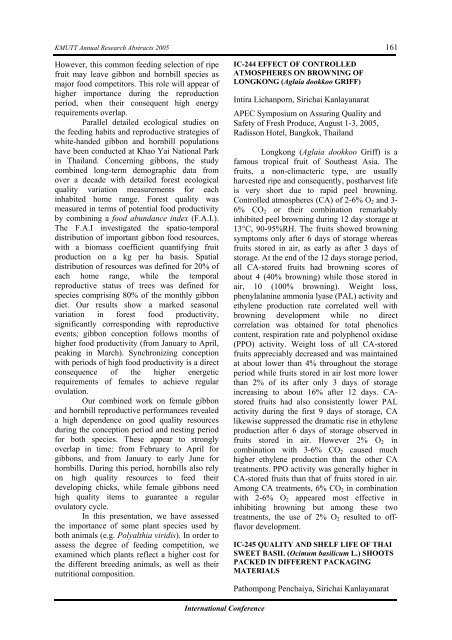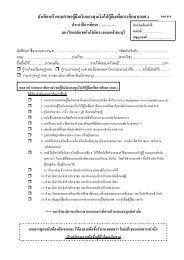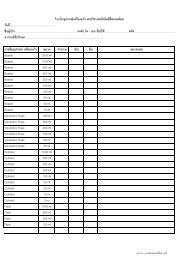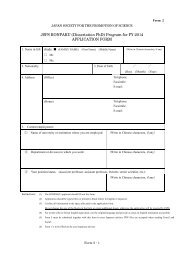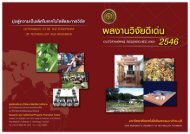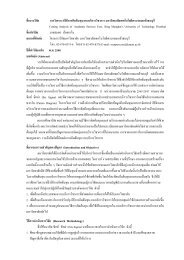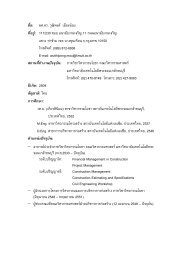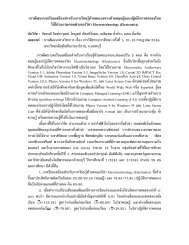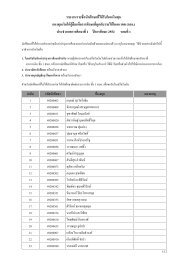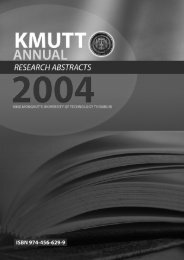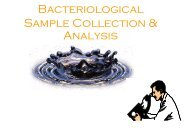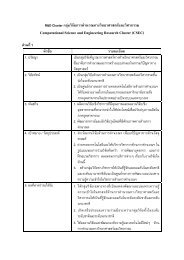You also want an ePaper? Increase the reach of your titles
YUMPU automatically turns print PDFs into web optimized ePapers that Google loves.
KMUTT Annual Research Abstracts 2005<br />
However, this common feeding selection of ripe<br />
fruit may leave gibbon and hornbill species as<br />
major food competitors. This role will appear of<br />
higher importance during the reproduction<br />
period, when their consequent high energy<br />
requirements overlap.<br />
Parallel detailed ecological studies on<br />
the feeding habits and reproductive strategies of<br />
white-handed gibbon and hornbill populations<br />
have been conducted at Khao Yai National Park<br />
in Thailand. Concerning gibbons, the study<br />
combined long-term demographic data from<br />
over a decade with detailed forest ecological<br />
quality variation measurements for each<br />
inhabited home range. Forest quality was<br />
measured in terms of potential food productivity<br />
by combining a food abundance index (F.A.I.).<br />
The F.A.I investigated the spatio-temporal<br />
distribution of important gibbon food resources,<br />
with a biomass coefficient quantifying fruit<br />
production on a kg per ha basis. Spatial<br />
distribution of resources was defined for 20% of<br />
each home range, while the temporal<br />
reproductive status of trees was defined for<br />
species comprising 80% of the monthly gibbon<br />
diet. Our results show a marked seasonal<br />
variation in forest food productivity,<br />
significantly corresponding with reproductive<br />
events; gibbon conception follows months of<br />
higher food productivity (from January to April,<br />
peaking in March). Synchronizing conception<br />
with periods of high food productivity is a direct<br />
consequence of the higher energetic<br />
requirements of females to achieve regular<br />
ovulation.<br />
Our combined work on female gibbon<br />
and hornbill reproductive performances revealed<br />
a high dependence on good quality resources<br />
during the conception period and nesting period<br />
for both species. These appear to strongly<br />
overlap in time: from February to April for<br />
gibbons, and from January to early June for<br />
hornbills. During this period, hornbills also rely<br />
on high quality resources to feed their<br />
developing chicks, while female gibbons need<br />
high quality items to guarantee a regular<br />
ovulatory cycle.<br />
In this presentation, we have assessed<br />
the importance of some plant species used by<br />
both animals (e.g. Polyalthia viridis). In order to<br />
assess the degree of feeding competition, we<br />
examined which plants reflect a higher cost for<br />
the different breeding animals, as well as their<br />
nutritional composition.<br />
IC-244 EFFECT OF CONTROLLED<br />
ATMOSPHERES ON BROWNING OF<br />
LONGKONG (Aglaia dookkoo GRIFF)<br />
Intira Lichanporn, Sirichai Kanlayanarat<br />
APEC Symposium on Assuring Quality and<br />
Safety of Fresh Produce, August 1-3, 2005,<br />
Radisson Hotel, Bangkok, Thailand<br />
161<br />
Longkong (Aglaia dookkoo Griff) is a<br />
famous tropical fruit of Southeast Asia. The<br />
fruits, a non-climacteric type, are usually<br />
harvested ripe and consequently, postharvest life<br />
is very short due to rapid peel browning.<br />
Controlled atmospheres (CA) of 2-6% O 2 and 3-<br />
6% CO 2 or their combination remarkably<br />
inhibited peel browning during 12 day storage at<br />
13°C, 90-95%RH. The fruits showed browning<br />
symptoms only after 6 days of storage whereas<br />
fruits stored in air, as early as after 3 days of<br />
storage. At the end of the 12 days storage period,<br />
all CA-stored fruits had browning scores of<br />
about 4 (40% browning) while those stored in<br />
air, 10 (100% browning). Weight loss,<br />
phenylalanine ammonia lyase (PAL) activity and<br />
ethylene production rate correlated well with<br />
browning development while no direct<br />
correlation was obtained for total phenolics<br />
content, respiration rate and polyphenol oxidase<br />
(PPO) activity. Weight loss of all CA-stored<br />
fruits appreciably decreased and was maintained<br />
at about lower than 4% throughout the storage<br />
period while fruits stored in air lost more lower<br />
than 2% of its after only 3 days of storage<br />
increasing to about 16% after 12 days. CAstored<br />
fruits had also consistently lower PAL<br />
activity during the first 9 days of storage, CA<br />
likewise suppressed the dramatic rise in ethylene<br />
production after 6 days of storage observed in<br />
fruits stored in air. However 2% O 2 in<br />
combination with 3-6% CO 2 caused much<br />
higher ethylene production than the other CA<br />
treatments. PPO activity was generally higher in<br />
CA-stored fruits than that of fruits stored in air.<br />
Among CA treatments, 6% CO 2 in combination<br />
with 2-6% O 2 appeared most effective in<br />
inhibiting browning but among these two<br />
treatments, the use of 2% O 2 resulted to offflavor<br />
development.<br />
IC-245 QUALITY AND SHELF LIFE OF THAI<br />
SWEET BASIL (Ocimum basilicum L.) SHOOTS<br />
PACKED IN DIFFERENT PACKAGING<br />
MATERIALS<br />
Pathompong Penchaiya, Sirichai Kanlayanarat<br />
International Conference


